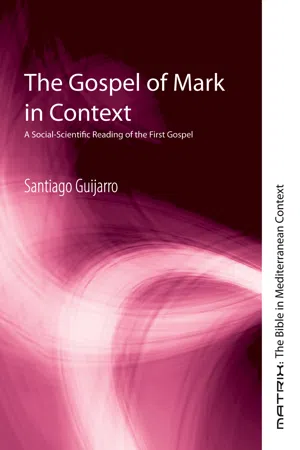![]()
chapter 1
The Composition of Mark’s Gospel
Introduction
Research on the Gospel of Mark has rightly emphasized the distinctiveness of the passion narrative (Mark 14–16) compared to the rest of the work (Mark 1–13). The differences between these two parts of the gospel are literary and theological. From the literary point of view, the passion narrative has a very concrete setting, a clear chronological framework, a well-balanced plot, and well-defined characters. However, in the earlier part of the Gospel, the geographical and chronological context is more generic, the plot is more diffuse, and the characters less consistent. From the theological point of view, the image of Jesus as the suffering Messiah, which appears progressively in the first part of the narrative, comes to the foreground in the passion story.
The narrative consistency of the passion story suggests that Mark used a passion narrative that circulated in the groups of Jesus believers. Although the canonical Gospel of John and the apocryphal Gospel of Peter report versions of this ancient narrative, scholarly consensus has coalesced around no single reconstruction of it. Despite that, a detailed redactional analysis of the last chapters of Mark allows us to reconstruct the pre-Markan passion narrative.
This reconstruction of the pre-Markan passion narrative can help explain the Gospel’s composition because many of the redactional changes introduced by the evangelist are intended to link it with earlier chapters. This observation raises the question of whether in Mark 1–13 there are references to the passion designed to merge both parts. Rhetorically, the redactional changes in Mark 1–13 would function to anticipate (prolepsis) some critical aspects of the passion narrative, while the changes in Mark 14–16 would recall (analepsis) some aspects of Jesus’ activity. These changes would contribute to render the whole story more coherent.
This observation is the starting point of the thesis about the composition of Mark presented in this chapter. My thesis will reveal both Mark’s literary originality and its theological import. This chapter will also set the stage for a discussion of the date and location of the Gospel’s composition.
Editorial Changes in Mark 14–16
The changes introduced by Mark into the traditional passion story are of three types. First, he added some editorial seams to link independent traditions (Mark 14:1−2, 12, 32). Second, he introduced small additions to some episodes of the traditional story (Mark 14:28, 43, 55b, 61b−62, 72b; 15:10, 21, 22b, 27, 31−32, 39, 40−41, 42b, 43b; 16:7−8). Third, he incorporated into the traditional passion narrative some independent traditions (Mark 14:3−9, 10−12, 22−25, 32−42, 51−52; 15:16−20a). Most of these editorial modifications introduce certain themes characteristic of Mark 1–13 into the passion narrative.
Two additions are clearly intended to link the passion of Jesus with the previous chapters. The first is the promise of seeing him in Galilee after the resurrection (Mark 14:28). The second evokes this same promise in the empty tomb scene (Mark 16:7). Both verses are redactional and break the sequence of the traditional scene. They are relevant because the setting of Jesus’ public activity in Galilee is one of the characteristic features of Mark’s Gospel. Mark mentions this region in the summaries and editorial seams that provide a uniform geographical framework for traditions that initially did not have such a precise setting. These two mentions of Galilee in the passion narrative serve to unite the first thirteen chapters and the passion narrative.
Mark has pursued this same goal by introducing the scribes into the passion narrative. In their five appearances, they show up together with the chief priests (Mark 14:1, 43, 53; 15:1, 31). The mention of the scribes in 15:1 and 15:31 is evidently redactional. In Mark 14:1, they are mentioned in an editorial summary. In the scene where Jesus’ appears before the high priest, the allusion to them is also secondary (Mark 14:53b), as later, only the high priest and the chief priests are mentioned, but not the scribes (Mark 14:55, 60, 63). It is therefore reasonable to think that the mention of the scribes in Mark 14:43 is also redactional and that the pre-Markan passion narrative did not contain any references to the scribes. Still, the scribes are, together with the Pharisees, the main adversaries of Jesus during his public activity (Mark 2:6, 16; 3:22; 7:1, 5). Their mention in the passion narrative evokes the opposition to Jesus during his activity in Galilee, and thus links his passion and that activity.
Editorial changes are another means of linking both parts of the narrative. Some of these involve the...
